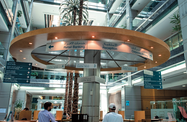Positive first half results from leading banks, rising business confidence and a predicted surge in consumer spending are expected to boost lending and earnings in Dubai’s financial services sector.

Emirates NBD saw its profits rise 5% year-on-year (y-o-y) to Dh3.9bn ($1.1bn) in the first half of 2017, helped along by solid net interest earnings, which grew by 2%, as well as reductions in costs and provisions, according to the bank.
Improved margins and controlled loan growth also helped lift profits, Surya Subramanian, CFO of Emirates NBD Group, told press last month, with rises of 5% and 3% recorded in lending and deposits, respectively.
The sharia-compliant segment of the market saw improved returns over the same period. Dubai Islamic Bank’s profits were up 7% y-o-y to Dh2.14bn ($582.6m), while Emirates Islamic Bank’s profits nearly doubled to Dh387m ($105.3m).
Recovering economy fuels banking optimism
The improved performance could carry through the rest of this year and beyond if economic projections from a number of stakeholders play out, with expansion in major industries potentially providing new lending opportunities for Dubai’s banks.
According to July estimates from the Economic Development Committee, Dubai’s GDP is projected to rise by 3.1% this year and 3.5% next year – up from 2.9% in 2016 – driven by higher infrastructure investment and robust growth in certain sectors.
The real estate industry, for example, is set to expand by 4.3% and 3.8% this year and next, respectively, while manufacturing is forecast to grow by 3.3% and 4.1%.
With solid levels of capitalisation, Dubai’s banks are well placed to take advantage of increased credit demand as the economy gains momentum, according to Arshad Ghafur, president for MENA at Bank of America Merrill Lynch.
“The banking sector in this region is very well capitalised – stronger than many others in the world – while liquidity has improved significantly relative to levels a year ago.” Ghafur told OBG. “Further, while non-performing loans increased over the past year, credit quality is stronger than most people realise, especially for large companies, which are increasingly willing to deploy their balance sheets.”
Sentiment is similarly positive among the emirate’s broader business community, according to the latest Business Leaders’ Outlook Survey conducted by the Dubai Chamber of Commerce and Industry (DCCI).
The results of the survey, released in late July, showed that business leaders were more optimistic about the third quarter of the year, with 39% of respondents saying they felt business conditions would pick up in the second half of 2017 and just 18% expecting them to worsen.
The survey’s findings are reflective of the prevailing mood of business leaders in the UAE as a whole for the coming year. According to a UAE CEO survey published by Oxford Business Group the same month, 82% of respondents had positive or very positive expectations of local business conditions over the next 12 months.
Opening pathways
The rebounding Dubai economy and renewed assistance from the government are providing more support to small and medium-sized enterprises (SMEs), in particular.
Heightened controls aimed at keeping non-performing loans in check had impacted lending flows for smaller businesses, making it more difficult for smaller firms to access credit, according to Julian Wynter, CEO of Standard Chartered Bank UAE. Now, however, the authorities are implementing changes to make it easier for SMEs to access credit.
“The government is very focused on this area at the moment,” Wynter said. “Helping SMEs grow is central to their development agenda, and it should be, as they account for a huge proportion of businesses in the country.”
Significantly, sentiment among Dubai’s SMEs is more positive than that of larger companies, according to the recent DCCI survey. Almost 50% of respondents from the SME segment said they expected an improvement in business conditions in the third quarter of the year, compared to 25% from large firms.
Higher interest rates could impact borrowing costs
However, rising interest rates and the resulting impact on lending costs could affect the pace of banking sector growth. In June the US Federal Reserve increased its benchmark interest rate for the third time in six months, prompting a 25-basis-point rate hike by the Central Bank of the UAE.
“US interest rate rises are going to have an impact on borrowing costs, and many companies are beginning to think about how said changes will impact their funding activities,” Ghafur told OBG.
While the Federal Reserve had been broadly expected to increase rates at least once more this year, below-target inflation and soft jobs growth in August have raised some doubts about the timetable.
“[We] decided to maintain the target range for the federal funds rate at 1% to 1.25%,” Janet Yellen, chair of the Federal Reserve, said after the bank’s most recent open market committee meeting on September 20.


